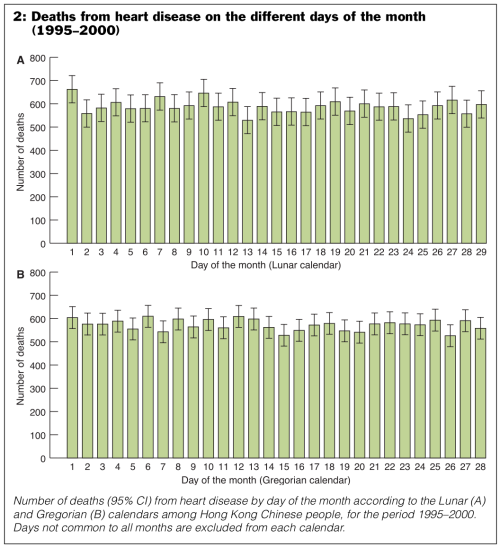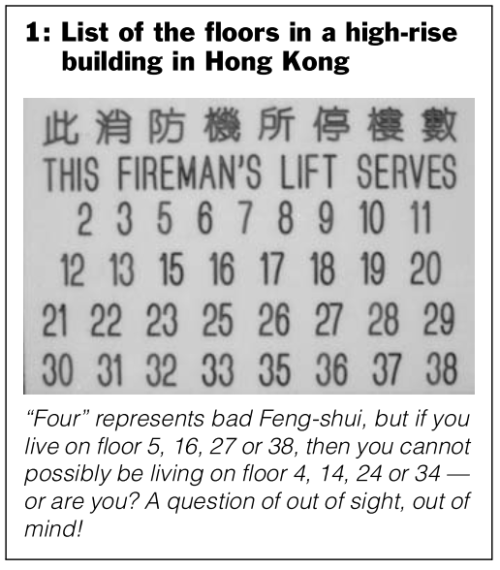Do superstitions kill? You may have heard the one about Chinese people dying in larger numbers on the fourth of every month because, in both Cantonese and Mandarin (and also in Japanese), the words for “four” and “death” sound the same. Imagine making a medical appointment on January “Death Day”. Might this not create enough stress to push your frail body over the edge?
The phenomenon even has a name: the Baskerville effect. In the Sherlock Holmes novel The Hound of the Baskervilles, the character of Charles Baskerville dies of a heart attack caused by extreme psychological stress.
Intrigued by this claim, I decided to look at the scientific data. Right off the bat, I was confronted by a study by Phillips and colleagues which reported that “cardiac mortality in Chinese and Japanese people peaked on the fourth of the month.”
And the graph the authors released, which shows mortality as a function of day of the month, is visually striking. There is indeed a noticeable peak on the fourth for Chinese and Japanese subjects, but not for whites.
![Bar graph showing the number of deaths from chronic heart disease, by day of month, from Phillips, D. P. et al. “The Hound of the Baskervilles effect: natural experiment on the influence of psychological stress on timing of death”. BMJ 323, 1443–6 (2001).]](https://www.mcgill.ca/oss/files/oss/styles/wysiwyg_extra_large/public/fig_1.png?itok=QY21oqld)
So what did the authors actually do here?
They looked at Chinese and Japanese Americans. First, they confirmed avoidance of the number 4 by looking at restaurant phone numbers in California since, at the time of the study, their telephone subscribers had “some choice of the last four digits in their telephone numbers”. They indeed found a pattern: Chinese and Japanese restaurants had significantly fewer fours in their phone numbers than American restaurants in California.
But does the number four precipitate deaths in a population that fears it?
The researchers looked at country-wide mortality numbers from 1973 to 1998. They matched Chinese and Japanese Americans to white Americans on a number of factors (state, cause of death, age, sex, marital status, and inpatient status). They then looked at deaths from chronic heart disease and how it varied according to the day of the month, and this is how we get the graph above, with the peak on the fourth of every month.
So is this the end of the story?
On the contrary, this Baskerville narrative is about to become a lot more interesting. So far, we think that superstition is involuntarily pushing certain people to their deaths. But if you truly were superstitious, would this not also have an impact on voluntary behaviour? It makes sense to think that accidental deaths and suicide would also go up on “death day” for Chinese and Japanese Americans. Yet, when Gary Smith, of the Department of Economics at Pomona College, looked into this, he found no correlation. Additionally, when he looked at the same “chronic heart disease” category Phillips had looked at, but for the years 1969-1988 and 1999-2001, he found nothing out of the ordinary.
And about these “chronic heart diseases”… Smith noticed a revealing choice made by Phillips and his colleagues. You see, when pulling out medical records to look at cause of death, a researcher needs to know the right ICD codes. “ICD” stands for “International Classification of Diseases”, and it is a standardized series of codes that identify diseases and health problems. For example, in the edition used by Phillips, code 410 means “acute myocardial infarction”, commonly known as a heart attack. ICD codes facilitate the types of studies like Phillips’. Instead of interrogating a registry using words that may not be standardized, you use numbers.
Smith points out that, in two previous studies conducted by Phillips which looked at similar correlations (Jewish deaths near Passover, Chinese deaths near the Harvest Moon Festival, and the fate of Chinese-Americans with unlucky birth years), all of the ICD codes for heart disease were used. In the Baskerville effect study, however, Phillips only used 5 of the 36 codes for heart disease. Smith reports that, for the 31 other categories, there is no excess of deaths on day 4 than on days 3 or 5. Is this, I wonder, an example of “researchers’ degrees of freedom”, meaning that a scientist runs various analyses and only reports on the ones that make their hypothesis look good?
The final nail in the coffin for me comes from Phillips’ own assumption: “Chinese and Japanese superstitious fears are likely to be stronger where they are reinforced by large Chinese and Japanese populations.” This is used to look specifically at deaths in the state of California, which has a particularly high population of East Asians and which accounts for almost half of all Chinese and Japanese deaths in the US. Phillips indeed finds an even larger effect of the “death day” when looking at this one state.
But taking this line of reasoning to its logical conclusion, we would expect to see an even bigger effect in Asia. This is what Panesar and colleagues tested by looking at Hong Kong.
They looked at the years 1995 to 2000 and used the same 5 ICD codes that Phillips had investigated; they also looked at both the Gregorian calendar and the Chinese lunar calendar; and they looked at the 4th, 14th, and 24th days of the month. The results? None of these days had an excess of deaths from “chronic heart disease”, in any calendar.
In Hong Kong. Where over 95% of the population speaks Cantonese. Where superstition over the number four is strong. No correlation.

They even looked at suicides on these days and found no association.
It seems that the Baskerville effect is the stuff of fiction and not reality. But one nagging result remains. How then do we explain the original study’s peak on the fourth of the month?
It boils down to what you compare it to. It may seem straightforward, but you can compare Day 4 mortality to all sorts of things and get different results. For example, Gary Smith, in his rebuttal, decided to compare Day 4 to Days 3 and 5, whereas the original paper compared Day 4 to Days 1-3 and 5-7. Why? The original paper tried to take into account the fact that mortality for all Americans does increase during the first week of every month. Depending on how this increase is distributed along the week, you could mistake this overall increase for an increase in East Asian mortality on Day 4. The way to avoid that is to look at the day before and the day after, which the original authors did not do.
And, as epidemiologist Dr. Christopher Labos tells me, “reporting that the number of deaths on Day 4 was higher than the average for the first week of the month is not quite the same thing as saying you are more likely to die on Day 4”.
If I say, “are you more likely to die on Day 4 than on Day 17?”, the answer would probably be “no”. Look at the graph below. The black line that pierces each column like the needle in a syringe represents the confidence interval. Each of these columns is an average of all twelve months. The number of deaths in January is not exactly the same as in August, and these black lines give us an idea of this distribution throughout the year. Comparing the confidence interval for Day 4 with that of Day 17, we can see that there may not be a significant difference.
![Bar graph showing the number of deaths from chronic heart disease, by day of month, from Phillips, D. P. et al. “The Hound of the Baskervilles effect: natural experiment on the influence of psychological stress on timing of death”. BMJ 323, 1443–6 (2001).]](https://www.mcgill.ca/oss/files/oss/styles/wysiwyg_extra_large/public/fig_1.png?itok=QY21oqld)
As Dr. Labos concludes, “while the number of deaths on Day 4 may be higher than average, it is not actually statistically higher than any individual day.”
Good science is built on reproducible results. The original Phillips study failed to be reproduced. Moreover, its hypothesis would have repercussions for the Cantonese-speaking population of Hong Kong and possibly for accidental deaths and suicides. Again, none of these analyses panned out.
I do need to point out that emotional stress can cause a very specific type of heart problem called stress cardiomyopathy (also known as “broken heart syndrome” and which is different from a heart attack), and it may also be a risk factor for coronary artery blockages.
That being said, there is no good evidence that East Asians, superstitious of the link between “4” and “death”, die of heart attacks, heart disease, accidents, or suicide in greater number on the fourth of the month. But if you do want to see the superstition in action, go to Hong Kong and check the elevator panel in a high-rise building. Where are the 4th, 14th, 24th, and 34th floors?
Vanished into thin air, it would seem.

Want to engage with this content? Comment on this article on Facebook!







